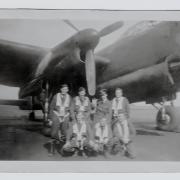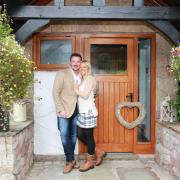Dogs have supported mankind for millennia, and, in Cheshire, Hearing Dogs for Deaf People show just how vital the human animal relationship can be

Dogs have been by our sides for thousands of years, hunting, shepherding, protecting, so the concept of working dogs is one we’re all familiar with. Indeed, a mural depicting a special relationship between a dog and a blind person was found in the ruins of Herculaneum, which was destroyed in AD79, which means support dogs have been in use for at least 2000 years. The UK charity Guide Dogs for the Blind was founded in 1931, and in 1982 Hearing Dogs for Deaf People was launched, placing their first dog, a rescue named Lady, in 1983. Each dog placed changes a life beyond our imagination.
“It’s very hard to put into words what having a hearing dog means to me,” says Christine Wright, from High Lane, near Stockport. “She’s by my side 24 hours a day. The bond that develops between you and your canine partner is indescribable. My second hearing dog had to be retired early due to medical problems following an attack by some dogs. I was without a dog for over six months and it was like losing my hearing for the second time. I had to revert to leaving the front door unlocked so people could come in if I didn’t hear the bell. My sleep became very disturbed as I was worrying about sounds that I would miss without my hearing aid and my hearing dog. When I was matched to Jessie the relief was instantaneous.
“Your hearing loss requires you to be made aware of the main sounds that hearing people take for granted. What this basically means is that you need help to be aware of doorbells, telephones, alarm clocks, cooker timers, smoke and fire alarms, burglar alarms and, if you are a parent, babies crying, etc. The charity also assesses how your hearing loss is affecting you in your day-to-day life and your wellbeing. Hearing loss affects the person in many more ways than an inability to hear sounds. Frustration and anxiety can also affect the person’s mental health. In my case I was missing alarm wake-ups, people phoning me, not answering the door to friends, feeling anxious and afraid because I could not hear the smoke alarm, and getting very frustrated when I was out and about and people were not understanding of my deafness. Having an assistance dog with you immediately alerts people to your needs. Being deaf can be very isolating, the jacket the dog wears opens up conversations and contact that I wouldn’t usually have, and cuts through the isolation.”
Christine now has her third hearing dog, Jessie, and during this time of coronavirus her presence has been even more rewarding.

“Face masks are an absolute nightmare. Having Jessie with me makes people much more likely to step back and take down their mask, so I can read their lips. I would never ask someone to do this, of course, but have been tremendously grateful when they do so voluntarily.
“People, once they understand what having the dog with me means, are usually very helpful. Cafés and restaurants can be very welcoming. We are frequently provided with a bowl of water for Jessie and space for her to lie down, and often they will turn the music down too, which makes it easier for me with my hearing aids.”
There are more than 30 hearing dogs working in Cheshire, and 89 puppy trainers within the Cheshire/Greater Manchester hub, training puppies that will be sent around the UK to support deaf people.
Gaynor Cavanagh, community fundraising manager North West, says: “Our volunteer trainers prepare our puppies and teach them how to become a working hearing dog by attending puppy classes, town visits and training within the home. They are given a dog at the age of eight weeks, which would then spend approximately the next 16 months in the home. There are no set qualifications needed but volunteers are looked after at all times and receive lots of training.”

One such volunteer is Wilmslow resident Caroline Roeves, who is currently bringing her third puppy, cocker spaniel Lady, up to scratch.
“I have always had dogs,” she says, “but when the last one died I said that I couldn’t have more as it’s just too upsetting to lose them. One day I was in Waitrose and Hearing Dogs for Deaf People were there, and they were looking for volunteers. I had my first dog five years ago, and Lady is my third.”
Love your pet? You’ll love this selection of dogs having some festive fun pics then!
There are two types of volunteer trainer, those who undertake the socialisation and the basics of training, and those who also do the sound training that will ready a dog for its working life.

“At the end of my first year with my first puppy I was asked if I would like to do the sound training as well,” Christine says. “We are tested all the way and at a certain point get given a jacket. Sound training involves her recognising certain sounds – from the oven beeper to the doorbell, telephone or smoke alarm, for example – and coming and ‘nudging’ me. When she nudges, I open my arms in a ‘what is it?’ gesture and she leads me to the source of the noise. They also learn the BSL signs for sit, lie down, etc, and a whistle for when they are off the lead.
“They are incredible animals and so quick to pick things up. Once you put the jacket on, they go straight into work-mode. They can be having full zoomies and it’s an instant transformation. Lady is great at the sound work, but sometimes doesn’t behave quite like a lady; she’s a squirrel chaser, so we’re working hard on that.”
Having a puppy of your own, and spending so much time socialising and training it must make it hard when it’s time to go, surely?
“It’s a sad moment, yes,” Caroline admits, “but you know they are going to do something absolutely vital. You can choose how quickly you want to accept a new puppy, too. Before Lady came, we had a gap of about a month, but it’s entirely up to you, so could have one the next week, if you wished.”
None of this comes cheap, of course, and fundraising is constant need.
“It costs £25,000 to take a puppy from birth through to being partnered with a deaf person,” Gaynor says. “This covers breeding our pups, which we do to ensure the health and welfare of our dogs, to carefully sourcing puppies from reputable external breeders when required, as well as basic training during their first year and advanced sound training on a one-to-one basis. It also covers all associated costs such as equipment, food, admin and vet bills, plus the time of dedicated trainers and support staff.
“Cheshire is quite a hotbed of fundraising activity for us. In ‘normal’ times the Cheshire branch fundraising volunteers attend events year-round; local fetes and fairs, bucket collections and the fantastic annual Woodland Walk at Arley Hall & Gardens. We are always looking for people to get involved in fundraising and awareness-raising activity throughout the county – anyone interested should contact me on gaynor.cavanagh@hearingdogs.org.uk.”
To learn more about Hearing Dogs for the Deaf, visit the website.




























